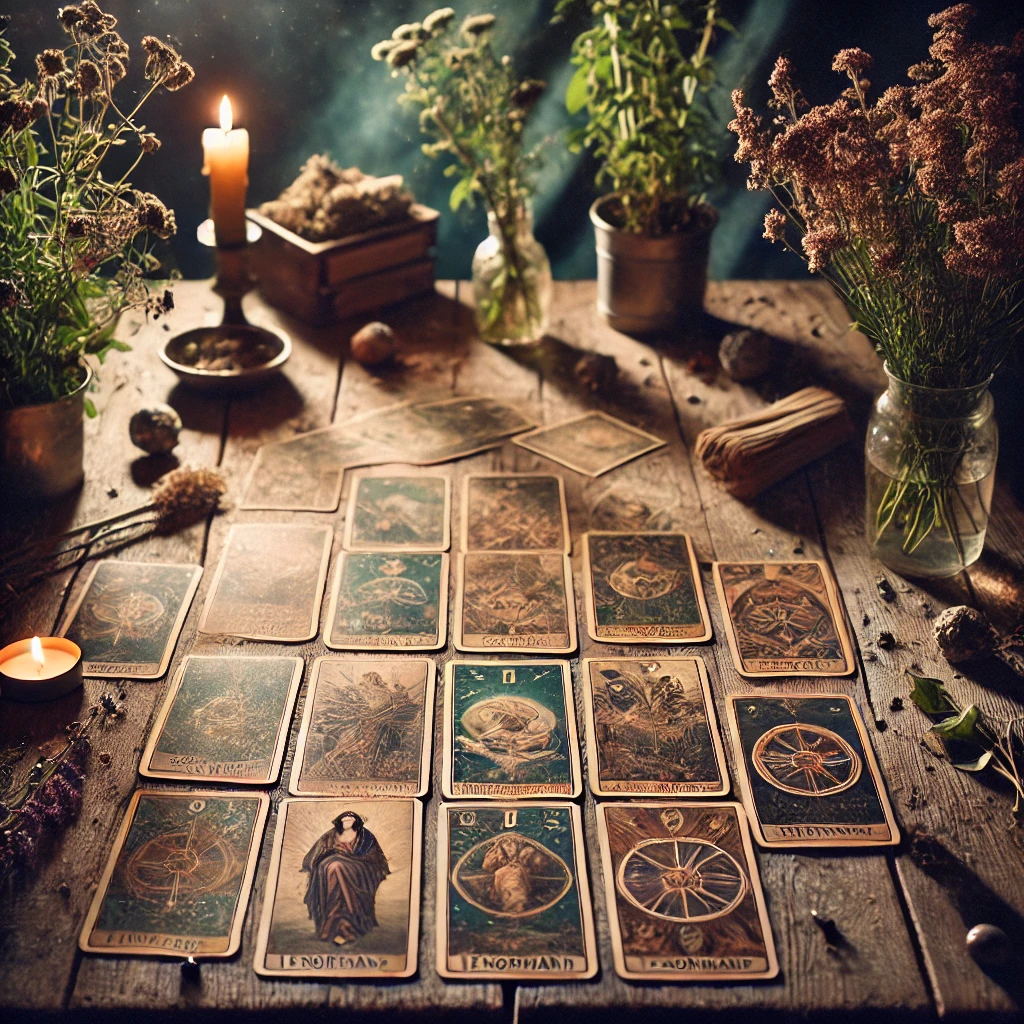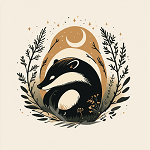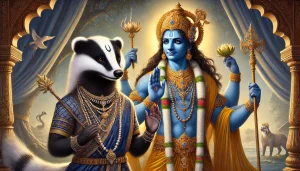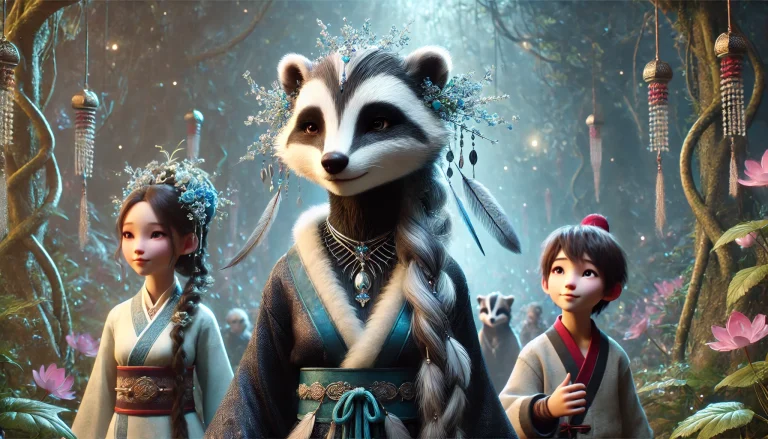This article offers a complete introduction to the Lenormand Deck, covering everything from the history and structure of the deck to the types of reading and practical methods. Ideal for beginners and practitioners, it teaches how to interpret the cards and use reading as a tool for self-knowledge.
Index
A Brief Introduction to the Lenormand Deck
The Lenormand deck is one of the most popular and respected methods of cartomancy, used to gain deep insights into life, the challenges and opportunities a person may encounter. Unlike the Tarot, which is made up of 78 cards, the Lenormand deck has only 36 cards, each with simple and straightforward images, but with powerful and multifaceted meanings.
Created in the 19th century, the Lenormand deck takes its name from Marie Anne LenormandMarie Anne Lenormand was a famous French fortune teller who gained fame for her readings for important historical figures such as Napoleon Bonaparte and his wife Josephine. Although Marie Anne Lenormand did not create the deck that today bears her name, her techniques and the popularity of her readings were fundamental to the development and dissemination of this method of cartomancy.
Each Lenormand card has a clear symbol, such as the Stork, the Sun, the Moon, the Cloverand the House, among others. These symbols are interpreted both individually and in combination with other cards, providing a reading rich in detail and nuance. The Lenormand is known for its objectivity and clarity, making it a valuable tool for beginners and experienced readers alike.
Over the years, the Lenormand deck has remained relevant and continues to attract new cartomancy enthusiasts. Its simplicity, combined with the depth of its interpretations, makes it a powerful tool for those seeking guidance and understanding through the cards.
History and Origin of Lenormand
A Brief History of Marie Anne Lenormand
- Full name: Maria Anna Adelaide Lenormand
- Date of birth: May 27, 1772
- Nationality: French
- Age: 71 years old
- Place of birth: Alençon, France
- Date of death: June 23, 1843
- Career: Writer, psychic
- Personal life: Never married
- Children: No children
When the midwife removed the child from her mother's womb, she was surprised: the girl not only had black hair, but also teeth. Maria told visitors to her salon that she had been born into a complicated family, where her mother had been seduced by a Catholic missionary and, after her husband's death, had abandoned her. Although this story was made up, the clients loved to hear it.
In fact, Mary was born in 1772 in Alençon, France, to a family of textile merchants. After her mother suffered a fall during pregnancy, Maria was born with some deformities. From an early age, she was known for being outspoken and making frightening predictions, which ended up isolating her family socially.
Sent to a Benedictine monastery, Maria made disturbing predictions about the nuns, which further increased her isolation. Fascinated by mysticism and esotericism, Maria devoted herself to studying these subjects intensively in the monastery library. When her father died, she returned home and found a deck of cards, thus beginning her journey as a fortune teller.
In 1790, Maria opened a fortune-telling salon in Paris. Her accurate predictions, including those for historical figures such as Josephine Beauharnais and Teresa de Cabarrus, brought her fame. She predicted the death of Marat and the beheading of Robespierre and Saint-Just, events that actually took place.
Maria also predicted the tragic fate of Queen Marie Antoinette. During the French Revolution, she was imprisoned, but her predictions saved her life. Josephine Beauharnais, after marrying Napoleon, confirmed Mary's predictions. Napoleon, suspicious of Mary's influence on Josephine, tried to silence her. However, Maria survived an assassination attempt and continued her practice.
Now over 70, Marie Lenormand lost interest in making predictions. She knew her days were numbered. According to legend, on the night of June 23, 1843, the fortune teller left the windows and doors of her house open. She wasn't wrong. A man wearing gloves and a mask quietly entered the house, picked up a pillow and pressed it against the old woman's face. She didn't resist because she knew that you can't escape fate...

Origin and Evolution of the Lenormand Deck
The Great Lenormand Deck was first published in France, in Paris, in 1835. At the time, Marie Anne Lenormand herself was still alive. However, it is very likely that she was unaware of the launch of the deck bearing her name, as she lived in seclusion in a country house.
Surprisingly, the fate of this Great Deck did not follow the same path as that of the 36-card Little Oracle. While the Little Deck gained great popularity almost immediately and, over time, was reprinted several times with designs by different authors and artists, the Great Oracle didn't enjoy the same success. All the illustrations in this deck have been preserved in their original form, without any alterations over the years.
It is curious to note that, in my opinion, many Tarot readers tend to ignore these cards completely undeservedly. The Great Lenormand Deck is a rich and complex tool that offers profound insights, but it requires practice and a well-developed intuition to be fully utilized.
Differences between the Lenormand Deck and Other Cartomancy Methods
The Lenormand Deck and other cartomancy methods, such as Tarot, are popular tools for divination and gaining insights into life and the future. However, they have significant differences in terms of structure, interpretation and approach. Here are the main differences:
- Deck structure
- Lenormand: The Lenormand deck consists of 36 cards, each with a simple and straightforward image, such as the House, the Clover, the Moon and the Sun. The cards are numbered from 1 to 36 and have more objective and specific meanings.
- Tarot: The Tarot, on the other hand, is made up of 78 cards divided into two main groups: the Major Arcana (22 cards) and the Minor Arcana (56 cards). The Major Arcana represent major themes and life lessons, while the Minor Arcana deal with more everyday aspects and specific details.
- Reading method
- Lenormand: Lenormand readings tend to be more direct and objective. The cards are often read in pairs or combinations to form phrases or sentences that describe the consultant's situation. The interpretation relies heavily on the interaction between neighboring cards.
- Tarot: The Tarot allows for deeper and more introspective readings, often exploring the psychological and spiritual aspects of a situation. Each card has a wealth of symbols and meanings that can be interpreted in various ways, depending on the context of the reading.
- Symbology
- Lenormand: The symbolism in Lenormand is simple and straightforward. Each card has a specific meaning that is easy to understand and apply. For example, the Scythe card usually indicates cuts or abrupt endings, while the Tree card represents health and growth.
- Tarot: Tarot cards are rich in symbolism and can have multiple meanings. The Tower card, for example, can indicate sudden change or destruction, but it can also represent liberation from limiting structures. Interpreting Tarot cards requires a deeper understanding of their symbols and archetypes.
- Reading Objective
- Lenormand: Lenormand readings are often used for practical, objective predictions. They are excellent for answering specific questions about future events or concrete situations.
- Tarot: Tarot readings tend to be more exploratory and introspective. They are used to gain insights into personal development, spiritual growth and deep understanding of complex situations.
- Interpretive Approach
- Lenormand: Lenormand's interpretative approach is more based on language and logic. The cards are read together to form a clear and cohesive narrative.
- Tarot: Tarot interpretation is more intuitive and symbolic. The Tarot reader uses their intuition and knowledge of the symbols to explore the multiple layers of meaning in each card.
These differences highlight how the Lenormand Deck and the Tarot, although both powerful divination tools, offer different approaches to card reading. The choice between them depends on the reader's personal preferences and the specific needs of the consultant.
Structure of the Lenormand Deck
Description of the 36 cards in the Lenormand deck
The Lenormand cards are a collection of symbols, objects and characters, each with a unique and profound meaning. Each card has a special meaning that can vary depending on its position in the layout and the cards it is adjacent to. The Lenormand deck reflects various areas of life, such as love, career, health, and other essential aspects of human existence.
One of the key elements in Lenormand card readings is the combination of the cards. These combinations can indicate specific events or circumstances that may occur in the future, offering a more detailed and accurate view of the consultant's situation.
Lenormand card reading requires practice and a good understanding of the symbolism of each card, as well as the ability to interpret these meanings in the context of the question or issue presented. Over time, the practitioner develops the ability to create cohesive and meaningful narratives from the card combinations, making the readings rich in detail and enlightening for the consultant.

Varieties and Expansions of the Lenormand Deck
The traditional Lenormand deck consists of 36 cards that have formed the basis of its readings since the 19th century. However, as the Lenormand has become more popular over the years, new decks have been created, bringing expansions and variations that have further enriched the interpretative possibilities. Among these modern decks, the Gilded Reverie Lenormanddeveloped by Ciro Marchetti, stands out for its visual beauty and the inclusion of additional cards that extend the traditional readings.
Additional cards in Gilded Reverie Lenormand
Gilded Reverie Lenormand introduces additional cards that go beyond the traditional 36, offering new archetypes and symbolisms for more complex situations. Some of these cards include:
- Owl (as a variation of Birds): It represents wisdom, mystery and introspection, bringing a deeper layer to readings related to communication.
- Watch: A symbol of time, cycles and deadlines, emphasizing the relationship with the right moment for actions and decisions.
- Bridge: It indicates connection, reconciliation and overcoming barriers.
- Data: They represent chance, luck and uncertainty, suggesting situations where risk is a predominant factor.
- Mask: A symbol of duality and disguise, indicating secrets or hidden intentions.
- Well: It refers to depth, hidden resources and the need to seek answers within oneself or in the environment.
- Compass: It represents direction, purpose and the search for guidance to find the right path.
- Labyrinth: An expansion of the social concept, indicating larger events or broad public environments.
- Magnifying glass: It symbolizes meticulous analysis, the need to examine details and pay attention to the small aspects of a situation.
How Extra Letters Enrich Readings
These additional cards offer more sophisticated nuances to the interpretations, allowing the reader to address contemporary and specific issues that are not always echoed in the traditional deck. For example:
- O Watch brings a sense of temporality that can highlight the urgency or patience needed in a situation.
- A Mask explores the dynamics of secrets and hidden intentions that often play out in relationships or business deals.
These new cards do not replace the traditional Lenormand, but complement it, making them a powerful tool for modern readings.
Why Use Decks with Additional Cards?
The inclusion of these letters allows readers to explore issues that go beyond the classic, such as changes in society, new relationship dynamics and contemporary challenges. With this, Lenormand remains relevant, evolving with the times while preserving its essence.
Basic Meanings of Each Card
- O Knight
- Keywords: News, message, information, letter, transport, movement, new ideas, invitation.
- Brief description: The Knight is the symbol of someone who brings news from afar. Its main meaning is related to impulse, activity and the start of a movement. It can represent a message or news that will bring change.
- O Clover
- Keywords: Expectation, hope, optimism, surprise, small pleasures, luck.
- Brief description: The four-leaf clover is a symbol of good luck. The card indicates favorable opportunities and joy, although the effects can be short-term.
- O Ship
- Keywords: Change, travel, progress, exchange, spiritual search.
- Brief description: The ship symbolizes travel and change. It represents new horizons and perspectives, bringing development and progress.
- A Home
- Keywords: Stability, security, home, family affairs.
- Brief description: The House is a symbol of security and stability. It refers to home, family and traditions.
- A Tree
- Keywords: Health, vitality, financial stability.
- Brief description: The Tree symbolizes growth and health. It indicates constant development and stability in various areas of life.
- The Clouds
- Keywords: Impending problems, uncertainty, anxiety.
- Brief description: Clouds are a symbol of trouble and confusion. They indicate a negative atmosphere and the need for patience until problems pass.
- A Snake
- Keywords: Betrayal, deceit, wisdom.
- Brief description: The Serpent symbolizes betrayal and deceit, but it can also represent wisdom and hidden knowledge.
- O Coffin
- Keywords: Conclusion, transformation, end, changes.
- Brief description: The Coffin symbolizes the end of something and transformation. It can indicate a dark period or the need to leave something behind.
- O Bouquet
- Keywords: Pleasure, joy, gift, surprise.
- Brief description: The bouquet symbolizes joy and gifts. It indicates happy events and pleasant surprises.
- A Scythe
- Keywords: Warning, important decisions, danger.
- Brief description: The Scythe is a symbol of the harvest and warns of danger. It indicates the need for quick and careful decisions.
- O Whip
- Keywords: Discord, fights, aggression.
- Brief description: The Whip represents conflicts and aggression. It indicates the presence of ongoing problems and communication difficulties.
- The Birds
- Keywords: Conversations, gossip, temporary worries.
- Brief description: Birds symbolize communication and small daily concerns. They indicate conversations and gossip that can cause unrest.
- The Child
- Keywords: Energy, youth, new beginnings.
- Brief description: The Child represents new beginnings and potential for growth. It indicates naivety and the need for care.
- The Fox
- Keywords: Deception, cunning, resourcefulness.
- Brief description: The Fox symbolizes deception and cunning. It indicates the need for caution and vigilance.
- The Bear
- Keywords: Power, strength, protection.
- Brief description: The Bear symbolizes power and authority. It indicates protection and the influence of a powerful figure.
- The Star
- Keywords: Luck, inspiration, hope.
- Brief description: The Star represents hope and inspiration. It indicates success and the fulfillment of desires.
- The Stork
- Keywords: Change, novelty, movement.
- Brief description: The Stork symbolizes positive change and renewal. It indicates new opportunities and fresh starts.
- The Dog
- Keywords: Devotion, friendship, trust.
- Brief description: The Dog is a symbol of loyalty and friendship. It indicates support and trust from close friends.
- The Tower
- Keywords: Protection, authority, solitude.
- Brief description: The Tower symbolizes power and structure. It indicates a strong position, but can also represent isolation.
- The Garden
- Keywords: Society, pleasure, social events.
- Brief description: The Garden represents socializing and public events. It indicates social interactions and pleasant encounters.
- The Mountain
- Keywords: Obstacles, difficulties, inactivity.
- Brief description: The Mountain symbolizes challenges and obstacles. It indicates difficulties that require patience and effort to overcome.
- The Way
- Keywords: Choice, decisions, uncertainty.
- Brief description: The Path represents important decisions and choices. It indicates the need to make a conscious choice.
- The Rats
- Keywords: Loss, damage, stress.
- Brief description: Rats symbolize loss and wear and tear. They indicate small problems that accumulate and cause stress.
- The Heart
- Keywords: Love, emotions, relationships.
- Brief description: The Heart is a symbol of love and emotions. It indicates deep feelings and affectionate relationships.
- The Ring
- Keywords: Unity, compromise, agreements.
- Brief description: The Ring represents commitments and unions. It indicates contracts, marriages and partnerships.
- The Book
- Keywords: Knowledge, secrets, wisdom.
- Brief description: The Book is a symbol of knowledge and secrets. It indicates the need to learn more or discover hidden information.
- The Letter
- Keywords: Communication, news, correspondence.
- Brief description: The card symbolizes messages and communication. It indicates the arrival of important news.
- The Man
- Keywords: Masculinity, activity, strength.
- Brief description: The Man card represents an important male figure or male energy.
- The Woman
- Keywords: Femininity, intuition, care.
- Brief description: The Woman card represents an important female figure or feminine energy.
- The Lilies
- Keywords: Nobility, harmony, purity.
- Brief description: Lilies symbolize harmony and purity. They indicate peace, serenity and dignity.
- The Sun
- Keywords: Success, joy, vitality.
- Brief description: The Sun is a symbol of success and happiness. It indicates positive energy and the achievement of goals.
- The Moon
- Keywords: Emotions, intuition, mystery.
- Brief description: The Moon represents the subconscious and emotions. It indicates intuition and internal processes.
- The Key
- Keywords: Solution, answer, discovery.
- Brief description: The Key is a symbol of solution and discovery. It indicates that the answer to a problem is close at hand.
- Fish
- Keywords: Abundance, wealth, spirituality.
- Brief description: Pisces symbolize wealth and prosperity. They indicate material and spiritual abundance.
- The Anchor
- Keywords: Stability, security, consistency.
- Brief description: The Anchor is a symbol of stability and security. It indicates a period of constancy and security.
- The Cross
- Keywords: Destiny, suffering, life lessons.
- Brief description: The Cross symbolizes destiny and challenges. It indicates difficult but important life lessons.
How the Cards Interact with Each Other
In the Lenormand deck, the interaction between the cards is essential for an accurate interpretation. The combinations of cards form phrases or sentences that describe the consultant's situation clearly and objectively. The position of the cards in relation to each other can significantly alter their meaning.
For example, the combination of the Knight card and the Clouds card can indicate worrying news or messages that bring uncertainty. On the other hand, the combination of the Knight and the Sun can mean good news e clarifications that bring clarity to the situation.
Another important interaction occurs between the Tree card and the Scythe card. When close together, they can suggest abrupt changes in health or decisions that impact well-being. If the Tree is next to the Clover, the interpretation changes to a speedy recovery or health improvements.
In addition, the Heart card combined with the Snake card can indicate love complications or betrayals. The Heart together with the Bouquet can suggest happy relationships or pleasant surprises in love.
These are just a few examples of how the Lenormand cards communicate with each other, forming narratives that can reveal important aspects of the consultant's life. The key to an accurate reading lies in considering these interactions and how they influence the overall meaning of the cards.
Types of Reading in the Lenormand Deck
In the Lenormand deck, the cards can be read in various ways, depending on the depth and complexity of the issue to be addressed. Different types of reading allow the consultant to explore everything from simple, straightforward questions to more complex, multi-faceted situations.
What are Card Readings?
Card readings are methods used to interpret the meaning of the cards in the deck and apply them to the consultant's life. Each reading can reveal insights into the past, present and future, providing guidance and clarity on specific issues. Lenormand readings are known for their precision and objectivity, with the cards forming sentences that clearly describe situations.
Common types of reading in Lenormand:
- Reading with 1 Letter:
- Description: The 1-card reading is the simplest and most straightforward. It is used to get a quick and objective answer to a specific question.
- When to use: Ideal for questions that can be answered with a simple word or idea, such as "Should I accept this offer?" or "What is the energy of my day?"
- Reading with 3 Cards:
- Description: The 3-card reading is more detailed and allows you to explore the past, present and future of a situation. Each card occupies a specific position which provides a more comprehensive view of the issue.
- When to use: Ideal for questions that require a more thorough analysis, such as "How will my relationship develop over the next few months?"
- Reading with 5 Cards (Line of 5):
- Description: The 5-card reading offers a deeper analysis, examining past, present and future influences, as well as additional nuances and possible challenges or supports in the situation.
- When to use: Useful for complex questions that require more detail, such as "What will be the main challenges and opportunities in my new job?"
- Reading with 9 Cards (Cube of 9):
- Description: In this reading, 9 cards are arranged in a 3×3 matrix, allowing for a richer and more detailed interpretation. This arrangement explores several layers of the situation, including the context, challenges and possibilities.
- When to use: Recommended for exploring a central question in multiple aspects, such as "How should I approach the coming months in terms of career, finances and personal life?"
- Reading with 36 Cards (Grande Tableau):
- Description: The reading with all 36 cards in the deck is the most comprehensive, offering a complete view of the consultant's life. Each card interacts with the others, providing a detailed and complex analysis.
- When to use: Ideal for comprehensive consultations that explore various aspects of the consultant's life over a given period of time.
3-Card Reading System in Lenormand
The 3-card reading method is one of the simplest and most accessible for beginners, as well as being very effective for quick and straightforward consultations. This system allows the consultant to get a clear view of a specific issue, providing a reading that is easy to interpret. Each card occupies a position that represents an aspect of time (past, present and future) or a sequence of events.
Step by Step to Reading:
- Preparation:
- Before you begin, it is important that you are in a calm and focused environment. Concentrate on the question or theme you want to explore with the cards. Shuffle the deck while thinking about the question.
- Distribution of cards:
- After shuffling, cut the deck and deal three cards in a row, from left to right. The order of the cards is crucial, as each one represents a different aspect:
- Letter 1 (Left): Past - This card reflects past influences that are impacting on the current situation. It can indicate events, emotions or decisions that have shaped the present.
- Letter 2 (Center): Present - This card represents the current state of affairs. It shows what is happening now, the challenges and opportunities the consultant is facing.
- Letter 3 (Right): Future - This card points to the likely course of events, based on present conditions. It shows where the situation is heading.
- After shuffling, cut the deck and deal three cards in a row, from left to right. The order of the cards is crucial, as each one represents a different aspect:
Interpretation:
When interpreting the cards, take into account both the individual meanings of each card and the interactions between them. The context and relationship between the cards can significantly influence the reading.
Reading example:
Question: "How will my career develop in the coming months?"
- Letter 1 (Past): The Fox - The Fox card may suggest that, in the past, the consultant has had to be cunning or deal with situations of mistrust and caution in the workplace. They may have faced challenges that required intelligence and strategy to overcome.
- Letter 2 (Present): The Garden - In the present, the Garden represents a period of socialization and expansion. The consultant may be attending events, meetings or even expanding their network of contacts. This card suggests that the current environment is conducive to growing and connecting with influential people.
- Letter 3 (Future): The Sun - The Sun, in the position of the future, indicates success and recognition. If you continue to take advantage of current opportunities and engage positively with others, you are likely to see very positive results in your career over the coming months, with achievements and prosperity in sight.

Reading Conclusion:
Based on the three cards, the reading suggests that although the past has required caution and intelligence, the present is a time of socialization and expansion that can lead to a bright and successful future. The consultant is encouraged to continue actively involving themselves in their network of contacts and to maintain a positive attitude, as this will bring favorable results for their career.
Preparing an Environment for Reading
Choose a quiet place where you won't be disturbed. Clear your mind and prepare a lined table where you can place the objects that help you concentrate. If you like, light some incense to create a more serene atmosphere. Sit comfortably and be present in the moment.
I could list many rituals and rules here, but the truth is that there are no strict rules. Just like a conversation between friends, a Tarot reading should be relaxed and done with confidence. The important thing is to find what makes you feel most secure and at ease. Have faith and allow yourself to explore this new world with an open mind and heart.
Conclusion
Card readings generally don't show an immutable future. What the cards do is reveal what is most likely to happen, based on the consultant's personality and current choices. However, a simple change of decision can completely alter the course of events. That's why, although a deck of cards can offer predictions about the future, I recommend using it primarily as a tool for self-knowledge and personal improvement. By using the cards in this way, you can work on your weaknesses and further strengthen your strengths, guiding yourself towards a more conscious and balanced life.
I'm passionate about magic and spirituality, always looking for new knowledge about rituals, energies and the mystical universe. Here, I share magical practices and spiritual tips for those who want to connect more deeply with themselves and the world around them, all in a light and accessible way.








